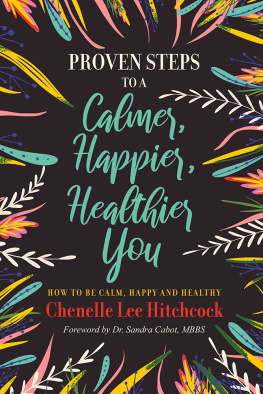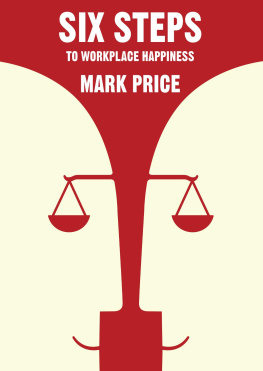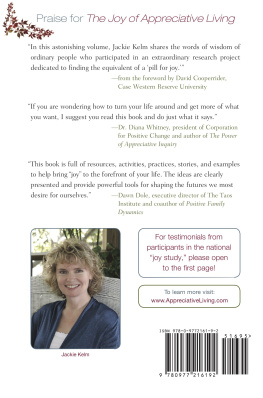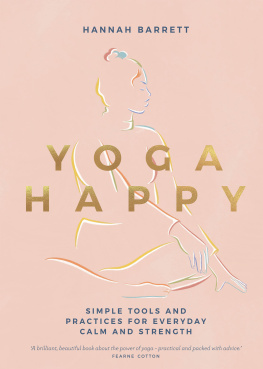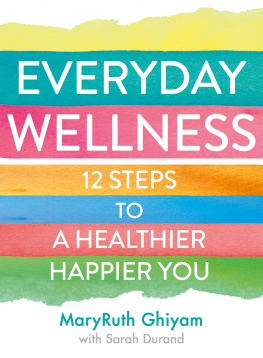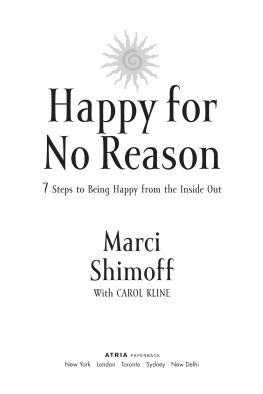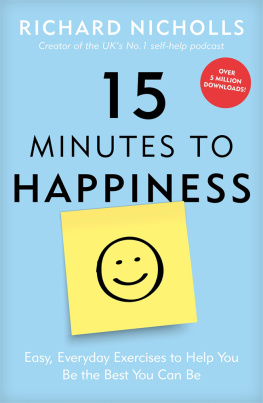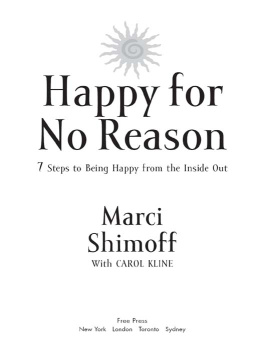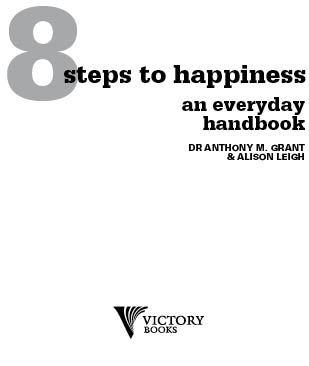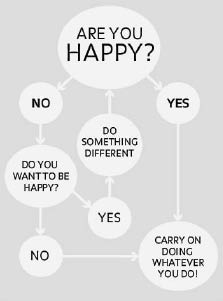This book is about happinessthe science of happiness. The ideas and exercises it contains are not only based on solid scientific research, they have been shown to work in practise.
The ABC television series Making Australia Happy , on which this book is based, followed eight individuals as they completed an intensive eight-week program using positive psychology interventions. The challenge was to radically improve their happiness and to verify it scientifically.
A specially selected Happiness Team was drawn from the fields of Positive Psychology, mindfulness and physiotherapy. Together Dr Anthony (Tony) Grant, director of the Coaching Psychology Unit at Sydney University; Dr Russ Harris, GP and a recognised expert in mindfulness; and Anna-Louise Bouvier, expert physiotherapist, supervised their progress and devised many of the exercises outlined in this book.
And it worked. All eight participants were far happier at the end of the program than at the start, and even more significantly the positive effects of participation were still evident twenty-four weeks after filming finished. This evidence-based program can work for you too. Eight weeks. Eight steps. Try it.
Part 1: Getting Started

Becoming happy

The habit of happiness
Its hard to be happy. Its hard to be really happy. To stay happy. Just when you think youve got it all worked out and it all seems in balancejust when you think, This is it!the feeling slips away. Optimism and contentment dissipate. Anxiety returns. We get downhearted. We give up.
Its easier to go shopping, to the movies, to eat nice food, to go on the internet, check Facebook, other distractions. It feels good. But the hedonic treadmillthe vicious cycle of searching for material things to make us happy and ease our disquietis just that, a treadmill. We end up coming back time and again to the same place: discontentment. How can we break this cycle?
Positive change is possible. It is relatively easy to improve our levels of happiness on a daily basis. There is now a considerable body of scientifically validated techniques that improve well-being, that can bring increased happiness and meaning into our lives. People can change. You can change. You can do it.
But heres the rub. The inconvenient truth. You have to do it. And you have to do it yourself. And you have to get into the habit of doing it. Positive change worksbut you have to work at it.
It would be nice if we could outsource our own personal development, to get someone else to do the work of change, but u nfortunately there is no real short-cut. There is no magic bulletbut there is science.
What we have done in this book is to put together a set of simple, science-based strategies that have been shown to be truly effective at developing the habit of happiness. There is no bullshit. No sleight of hand. No magic tricks.
Thats what is so useful about the Eight Steps to Happiness program. The eight steps in this book are all scientifically validated ways of improving happiness and well-being. They are designed to keep you engaged in the process over time. They offer new and varied experiences to help you move from insights to actions, from actions to habits.
Its easy to do something once. Its harder to do it twice, and even harder to stick at it over a period of time until it becomes a habit. The TRICK is to stick at it.
What is happiness?
Think of the word happiness and you might well visualise the ubiquitous yellow cartoon smiley face that has become synonymous with so-called positive thinking and the happiness industry. But what does being happy really mean to you?
Happiness is a state of mind characterised by experiences of contentment, satisfaction, love or joy. Happiness feels good. It feels worthwhile. Happiness is pleasurable.
But is pleasure alone enough? There is considerable enjoyment to be had in activities like shopping, eating, drinking, self-gratification and the pursuit of pleasure of the senses. But unfortunately these are often followed by feelings of emptiness and meaninglessness. We all love hedonistic pursuits of this kind. And they can certainly boost our enjoyment levels. But on its own the pure pursuit of pleasure, the purely hedonistic life, is ultimately disappointing. There is a lack of richness and depth.
The pleasurable life is only one part of happiness. The engaged life and the meaningful life are equally important. The engaged life is about owning your life. Its about feeling that you are purposefully involved in life activities such as work, relationships and recreational activities. The meaningful life is about having a sense of purpose, living a life that is coherent and consistent with ones values, a life that is a source of satisfaction.
Happiness comes from having a balance between pleasure, engagement and meaning. It is not one or the other. The lines between hedonistic pleasure and engagement in meaningful pursuits should not be drawn too tightly. In fact each influences and enhances the other. The research shows that having positive feelings tends to increase our sense of meaning, which in turns makes us feel good, and that this is further enhanced when we are engaged in the pursuit of meaningful goals in our lives.
There is a considerable amount of solid scientific evidence from philosophy, psychology, sociology, biology and recently from neuroscience to show that we can indeed improve our happiness. And there is good research to show that we can apply these techniques in our daily lives.
Take a moment to think about a time when you were truly happy. Chances are that you thought about times when you felt good, when you experienced pleasure, felt engaged and had a sense of being connected.
The happiness pie
Three factorsgenetics, life circumstances and choicemake up the happiness pie chart. But which is most influential in determining happiness?
The research from large-scale, population-level studies show that geneticsheritable factors such as temperamentgenerally accounts for about 50 per cent of the difference between individuals. Life circumstanceshow much money we have, where we went to school, where we livegenerally accounts for about 10 per cent of the difference between individuals. Which leaves as much as 40 per cent of the difference in levels of happiness for intentional activitiesthe choices we make on a day-to-day basis about how we live our lives.
Each of these factors is important. The relative contribution of each section of the pie to ones happiness is going to be different for everyone and this is because individuals vary. Nevertheless, the happiness pie chart provides a very useful reminder that our happiness is not pre-determined.


